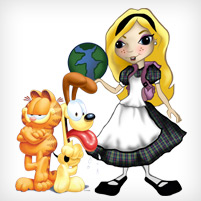Garfield & Friends

The Alice Project is making new friends.
Children who love Garfield, the world's most widely syndicated comic strip, can make their own computer animations of the lasagna-loving feline and his pals — and learn a bit about computer programming — with the latest version of Carnegie Mellon University's Alice educational software.
Wanda Dann, director of the Alice Project and a senior systems scientist in the Computer Science Department, said Alice 2.4, which is available as a free download from CMU, features Garfield, Odie, Jon, Nermel and other characters from the popular comic strip. The latest release is geared to appeal to middle and high school students.
Like all versions of Alice, the newest will enable novices to create animations using a simple drag-and-drop interface to select character objects, props and scenes from a large gallery of 3D models. Alice 2.4 joins Alice 3.1, a version primarily geared to students in higher-grade levels and in universities. Alice 3.1 contains the Sims2 characters, donated by Electronic Arts, and has options that support transition to the Java programming language.
Permission to add the Garfield characters to Alice was provided to the Alice developers through an agreement with Paws Inc., the company founded by cartoonist Jim Davis that manages the corpulent kitty's creative and business concerns. Garfield & Friends, created by Davis in 1978, appears in more than 2,100 newspapers worldwide and is read daily by 200 million people.
"Alice is used in classrooms around the globe, so we appreciate the influence an internationally recognized character such as Garfield has on school children," Dann said. "It says a lot about Jim Davis and Paws Inc. that they are willing to share these beloved and valuable characters with Alice. It means they really care about children and their education."
Education is a shared goal of Garfield and Alice, but so is fun. The late Randy Pausch, a CMU computer scientist famous for his inspirational "Last Lecture," led the development of Alice. He was convinced that students could learn something really hard, such as programming, by doing something really fun, such as creating computer animations with Alice.
Alice is used in more than 15 percent of colleges and universities and has become a popular teaching tool in secondary schools. Teachers in more than 30 countries now use Alice in their classrooms. Alice 2.4, with its Garfield characters and its menagerie of additional characters and props, is expected to be useful in introducing younger students to concepts of computer programming and computational thinking, Dann said.
Continued development of the Alice programming environment has been supported by grants from Oracle and the National Science Foundation.
Related Links: Alice Project | School of Computer Science | Computer Science Department | Randy Pausch's Last Lecture
